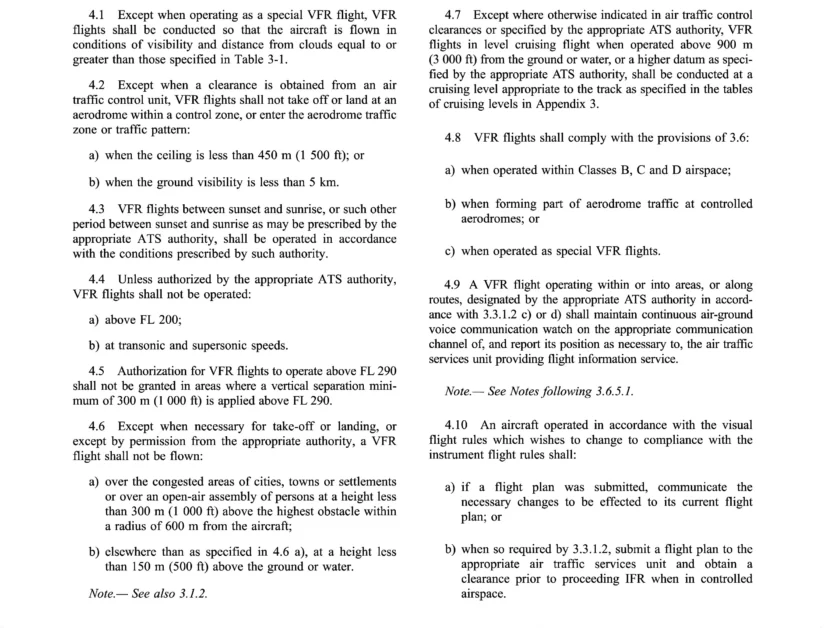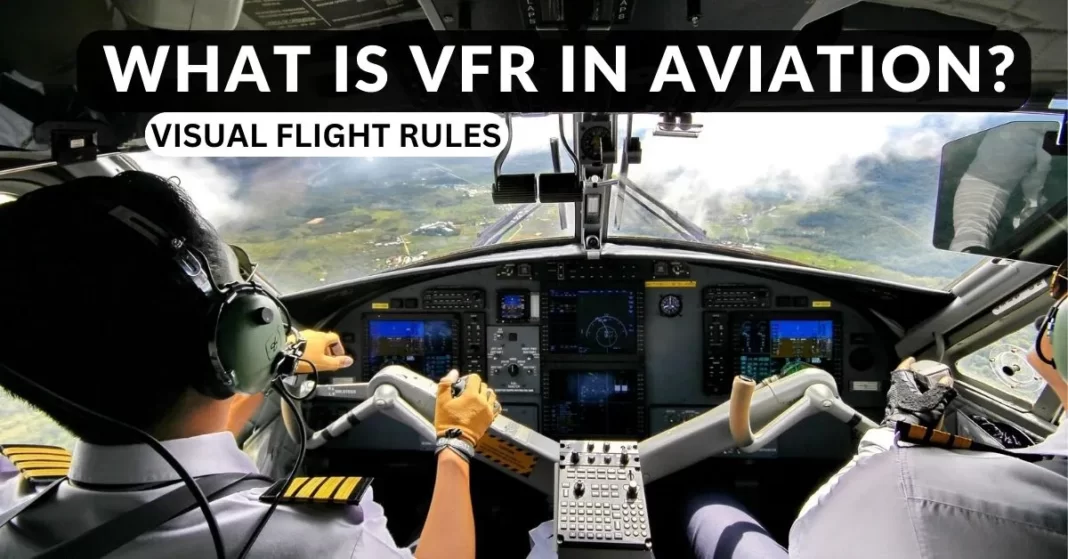In the complex world of flying airplanes, it’s really important to know the rules for how things work in the sky. One of these important rules is called Visual Flight Rules, or VFR for short. These rules help pilots know what to do and make sure that air traffic all around the world goes smoothly.
VFR lets a pilot fly a plane mainly by looking out the window, which is a key part of how flying works. This set of rules is like a big puzzle piece that helps make sure everything in aviation runs smoothly.
In this blog, we will explore the details of VFR in Aviation operations.
Table of Contents
Understanding what is VFR in Aviation
VFR, or Visual Flight Rules, is an aviation regulation under which a pilot operates an aircraft in weather conditions clear enough to allow the pilot to see where the aircraft is going. Essentially, this means the pilot must be able to navigate and control the aircraft by visual reference to the ground, and by visually avoiding obstructions and other aircraft.
VFR is one of two sets of rules governing all aspects of flight, the other being Instrument Flight Rules (IFR). IFR conditions occur when weather conditions are poor and the pilot cannot navigate the aircraft by sight alone. VFR, by contrast, is used when conditions are good.
The usage of VFR and IFR is often related to the weather conditions but can also depend on the airspace classification. Importantly, though VFR pilots primarily use their vision to navigate, they also have the responsibility to keep an eye out for other aircraft to avoid collisions, a concept known as “see and avoid”.
What is the Importance of VFR in Aviation?
Visual Flight Rules, known in the aviation industry as VFR, play a crucial role in ensuring aircraft safety. These regulations considerably decrease the possibility of mid-air collisions by establishing minimum meteorological conditions for different classes of airspace, providing guidelines for pilot certification, and detailing specifics for aircraft operations and maintenance.
Notably, VFR rules disallow flights in some congested airspaces around key airports without clearance from the air traffic control. Therefore, pilots’ strict compliance with VFR is fundamental for maintaining seamless and safe flight operations, especially in busy airspaces.
How does VFR Operate?
Fundamentals of VFR in Aviation
VFR, standing for Visual Flight Rules, refers to guidelines that govern the operation of an aircraft in weather conditions usually clear enough to provide pilots with visual reference to their surroundings. The core idea of VFR essentially lies in enabling pilots to navigate and maintain control of the aircraft by observing the horizon and landmarks, rather than relying solely on the cockpit’s instruments.
In a VFR flight, there are specific altitude and speed restrictions that pilots must adhere to, based on whether they are navigating controlled or uncontrolled airspace.
Furthermore, they must maintain a certain distance from clouds to ensure sufficient visibility. VFR flights largely depend on favorable weather conditions, as pilots need to visually spot and avoid other aircraft to prevent collisions. This is why VFR flights are predominantly scheduled during daylight hours.
Understanding VFR in Aviation

In Aviation, Visual Flight Rules (VFR) are guided by the Federal Aviation Administration (FAA) in the United States. The FAA has set certain “VFR weather minimums” that outline the necessary weather conditions for VFR flights. This could vary based on the type of airspace, with highly regulated rules in place in the airspace surrounding major airports. VFR flying is typically prohibited in certain restricted areas or in and around large airports where Instrument Flight Rules (IFR) take precedence.

It’s important to note that pilots operating under VFR are required to manage their own aircraft separation and avoid collisions, hence the need for clear weather conditions. To become certified to fly under VFR, pilots need to complete a requisite number of training hours, demonstrate proficiency in a variety of maneuvers and navigation skills, and successfully pass written and flight examinations.
Difference between VFR and IFR in Aviation
Visual Flight Rules (VFR) and Instrument Flight Rules (IFR) are two primary operational standards defined by the Federal Aviation Administration (FAA) to govern aircraft operations. VFR requires pilots to predominantly rely on external visual references to steer and control their aircraft.

The weather conditions must be generally clear, ensuring the pilot has a good view of the aircraft’s path. The FAA stipulates a minimum visibility of three miles under VFR conditions and the aircraft must maintain a certain distance from clouds. For night VFR flights, pilots are required to meet additional needs, including ensuring their aircraft is well-lit.
IFR, conversely, comes into play when weather conditions fall below the VFR minimums, or when an aircraft is operating in Class A airspace. IFR pilots depend substantially on the aircraft’s instruments for navigation and control, thus the term ‘Instrument Flight Rules’ is used.
Operating under IFR necessitates a higher level of training and usually includes additional certification that exceeds that of VFR operations. Flying under IFR demands not only the ability to navigate the aircraft using instruments alone but also proficiency in handling navigation and air traffic control procedures.
When it comes to aircraft equipment, IFR-certified aircraft usually have more sophisticated being equipped with specific navigation and radio equipment necessary for instrument approaches, while those used for VFR flights can be simpler.
In terms of pilot license, pilots must be IFR-certified to fly in IFR conditions, whereas a basic private pilot license can allow one to fly VFR. While each set of rules has its own unique requirements and procedures, both aim to ensure safe and orderly flight operations in all conditions and airspace.
Unraveled through the above discourse, the essence of Visual Flight Rules, its operational dynamics, and distinguished comparison with Instrument Flight Rules, one begins to comprehend that VFR is not merely a set of regulations but rather the heartbeat of aviation.
It fundamentally influences how pilots navigate, the freedom it accords under conducive conditions and the pivotal role it plays in the grand scheme of global air traffic control. By understanding VFR, we don’t just decode the language of the skies but also appreciate the precise choreography of countless flights dotting the firmament every day.
Conclusion on ‘What is VFR in Aviation?’
Visual Flight Rules (VFR) stand as the common rules for flying airplanes. They allow pilots to fly when the weather is clear, and they can see the ground and other planes. During VFR flights, pilots depend on their eyes to steer and avoid other aircraft.
Flying using VFR offers several benefits. VFR flights are usually cheaper compared to flying by instrument rules (IFR), and they offer more flexibility in terms of choosing the route and altitude. Planning and carrying out VFR flights are also generally simpler than IFR flights.
However, there are downsides to VFR flying as well. VFR flights are more affected by weather, and they become riskier during bad weather. Pilots using VFR also need to be extra careful in keeping an eye out for other aircraft.
All in all, VFR serves as an excellent choice for pilots who want to enjoy flying in clear weather. Nevertheless, understanding the limitations and taking precautions is important to manage the potential risks.





